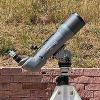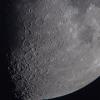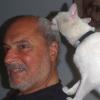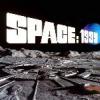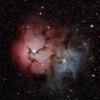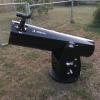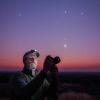
Optical and mechanical diagram/s of 45° and 90° binoculars. How is optical cone bent and ipd adjusted?
#1

Posted 04 June 2020 - 05:51 AM
I had been googling for some time now yet not have found the tech/drawings/diagrams to clearly illustrate optical cone bending and ipd adjustment systems and if possible pros and cons of systems.
I will much appreciate any sketch or links provided.
Sincere apologies if the question is not composed clearly, I am an absolute beginner in astronomy & binoculars.
Thanks!
#2

Posted 04 June 2020 - 06:10 AM
Hi Amiran,
this is a wide theme, I will give it a start and hope others will chime in :-)
First there are 90° mirror solutions:
The EMS System of Tatsuro Matsumoto is using just two mirrors (reflections) and providing an upright and side right view.
But the IPD adjustment is somewhat tricky.
Then there are three mirror (reflection) solutions the most known is the one of Binoptik. IPD adjustment is easy, the view upright but side reversed
There are 45° and 90° prism solutions. All are providing upright and side right views.
The 45° solution using a roof prism has 5 reflections
The 90° solution uses a penta and a porro prism and has 6 reflections.
For mirror solutions you can use all available refractor objectives.
With prism solutions it is way more complicated, you have to take care of the glass path through the prisms, all optical parts do need to be calculated together.
For this reason you can not take the objective lensed out of a prism binoscope and use them with mirrors.
Here you can find more informations:
http://www.photonics...book/v2ch04.pdf
Jochen
- Amiran likes this
#3

Posted 04 June 2020 - 10:23 AM
.....
.....
.....
The EMS System of Tatsuro Matsumoto is using just two mirrors (reflections) and providing an upright and side right view.
But the IPD adjustment is somewhat tricky.
.....
.....
.....
Is it?
Can you explain? Thanks.
Pinac
#4

Posted 04 June 2020 - 10:28 AM
Jochen covered the two and three mirror 90° solutions used in binoscopes so I'll describe the 45° and 90° prismatic solutions.
Earlier prismatic BT designs used a 2-reflection semi-penta prism (45°) or 2-reflection penta (90°) prism to deviate the light path 45° or 90° followed by a Porro II prism in a rotating turret to provide image correction (upright, L-R correct). The offset of the Porro II prism inside the turret allows IPD adjustment as the turret is rotated.
More common now, BTs use a 4-reflection Schmidt roof prism (45°) or 2-reflection Amici roof prism (90°) which provides the angle deviation as well as image correction. The roof prisms are followed by a 2-reflection rhomboid turrets that offsets the optical axes for IPD adjustment.
Some prism diagrams are shown below. The Porro II (Abbe-Porro) is shown in fig. 3 in Jochen's attachment.
Shown in order are semi-penta, penta, Schmidt roof, Amici roof and rhomb.
Rich
Edited by Rich V., 04 June 2020 - 10:29 AM.
- ArsMachina, Pinac, vilchez and 1 other like this
#5

Posted 04 June 2020 - 11:55 AM
Is it?
Can you explain? Thanks.
Pinac
It depends on EMS module.
If you have fixed EMS without IPD adjustment mechanism, most likely IPD adjustment is done by shifting OTA distance horizontally.
So you don't need to refocusing.
With helical IPD adjustment equipped EMS, distance between two OTAs is constant but
it changes length of EMS unit when you change IPD.
Therefore you need to refocus. I think that this is what Jochen meant "tricky."
Maximum IPD setting:

Minimum IPD setting:

Tammy
- ArsMachina likes this
#6

Posted 04 June 2020 - 12:41 PM
Hi Amiran,
this is a wide theme, I will give it a start and hope others will chime in :-)
First there are 90° mirror solutions:
The EMS System of Tatsuro Matsumoto is using just two mirrors (reflections) and providing an upright and side right view.
But the IPD adjustment is somewhat tricky.
Then there are three mirror (reflection) solutions the most known is the one of Binoptik. IPD adjustment is easy, the view upright but side reversed
There are 45° and 90° prism solutions. All are providing upright and side right views.
The 45° solution using a roof prism has 5 reflections
The 90° solution uses a penta and a porro prism and has 6 reflections.
For mirror solutions you can use all available refractor objectives.
With prism solutions it is way more complicated, you have to take care of the glass path through the prisms, all optical parts do need to be calculated together.
For this reason you can not take the objective lensed out of a prism binoscope and use them with mirrors.
Here you can find more informations:
http://www.photonics...book/v2ch04.pdf
Jochen
Thanks for document. Such a variety of prismatics.
#7

Posted 04 June 2020 - 12:44 PM
Jochen covered the two and three mirror 90° solutions used in binoscopes so I'll describe the 45° and 90° prismatic solutions.
Earlier prismatic BT designs used a 2-reflection semi-penta prism (45°) or 2-reflection penta (90°) prism to deviate the light path 45° or 90° followed by a Porro II prism in a rotating turret to provide image correction (upright, L-R correct). The offset of the Porro II prism inside the turret allows IPD adjustment as the turret is rotated.
More common now, BTs use a 4-reflection Schmidt roof prism (45°) or 2-reflection Amici roof prism (90°) which provides the angle deviation as well as image correction. The roof prisms are followed by a 2-reflection rhomboid turrets that offsets the optical axes for IPD adjustment.
Some prism diagrams are shown below. The Porro II (Abbe-Porro) is shown in fig. 3 in Jochen's attachment.
Shown in order are semi-penta, penta, Schmidt roof, Amici roof and rhomb.
Rich
Thanks for Illustrations.
Can one think of cons of using Schmidt prisms on diy binoscope builds?
I so much like the look ans IPD adjustment method of WWII Flaks and similar binos, why astronomers are not building that way ?
Thanks for kind responses to everyone.
#8

Posted 04 June 2020 - 01:08 PM
With helical IPD adjustment equipped EMS, distance between two OTAs is constant but
it changes length of EMS unit when you change IPD.
Therefore you need to refocus. I think that this is what Jochen meant "tricky."
Exactly Tammy,
I had an EMS with helical IPD adjustment.
It was very good as long as I used the binoscope just alone, but sharing it with others was no much fun, especially when the persons were not used to the system.
But the 2 reflection system with upright and side correct views of Tatsuro is really ingenious.
Every system has advantages and disadvantages.
I love big apertures and short focal length to provide the widest possible fields.
This is not possible with available APO objectives and a mirror setup.
Only the combination with the glasspath of prisms can do this and so the 150mm APM SD with just 840mm focal length is my holy grail.
But if you are into longer focal length, perhaps for a planetary binoscope, an EMS binoscope with just two reflections and the minimal possible light loss is the way to go.
Jochen
Jochen
- Amiran likes this
#9

Posted 04 June 2020 - 01:38 PM
Can one think of cons of using Schmidt prisms on diy binoscope builds?
Either Schmidt or Amici roof prisms can show the "spike" common to any roof prism if the roof edge bisects the principal optical axis as many small binos do. There is also the phase interference common to roofs that bisect the light cone then re-combine it that must be dealt with by phase coatings.
To overcome these limitations, BTs commonly incorporate an oversized roof prism that allows the roof edge to remain out of the light path. Light enters through one half of the entry face and leaves out the opposite half of the exit face. This eliminates the spike and the phase interference problems caused by splitting the light path.
Rich
- Pinac and Amiran like this
#10

Posted 04 June 2020 - 03:10 PM
In re # 2 above:
Upright and unreversed laterally images require an even number of reflections. A roof reflection which splits the light cone counts as two reflections.
Deja Vu many times: The system should be calculated as a whole, INCLUDING THE EYEPIECES. This is particularly true of steep light cones. So, the current practice of use of interchangeable eyepieces, from any source, is suboptimal. See Mil Handbook 141, or other instruction source for optical design.
I learned this truth the difficult way, through time-wasting eyepiece substitutions on the Fuji 25 x 150 (F/5) , and especially on the F/3.5 WW II Busch design 10 x 80 Flakfernrohr. However, there was one substitution, by previous owner or WW II technician, of the the Zeiss eyepiece from the F/4 , 80 degree deviation 10 x 80mm, onto the F/3.5 Busch 10 x 80 ( Busch, Schneider, Leitz, Feuss, Warsaw factory, etc. production) which performs well, except that the magnification is slightly less than 10X, having a 30mm. eyepiece instead of the Busch design 28mm f.l. This performance anomaly may be because the prism glass path length and glass type are similar or nearly equal in both of those binocular designs.
Random eyepiece substitutions, in my experience above, resulted in inferior field corrections. Axial or near- axial performance may be tolerable . There are many variables. Note that the current KOWA uses eyepieces designed for it, as did the prewar Zeiss 60, 80, and 110 mm mounted binoculars. Presumably, the Fuji 40X 150 mm. has custom design eyepieces.
Edited by Gordon Rayner, 04 June 2020 - 03:12 PM.
- ArsMachina, Pinac and Amiran like this
#11

Posted 04 June 2020 - 03:34 PM
For insight into two miror erecting systems, see the beamprints of the second type (unsplit light cone) Amici prism in one of Hopkins' chapters in Mil Handbook 141. I started thinking about a mirror erection system , after seeing that well- drawn figure, years before the 1982 (IIRC) article by Matsumoto-San in Sky & Telescope magazine.
Later, I wrote a program for HP -48 which calculates various layout spacings and angles for arbitrary deviations of 2-mirror erecting systems.
From 60 degrees up to about 120 degrees deviations of the sight line, and not only 90 degrees, appear to be practical. But I have not built any yet, though have spent considerable time devising various mechanical schemes for changing the interpupillary distance to suit the observer. Considerable simplification results if only one IPD is chosen, or is variable in a workshop situation, rather then in real time in the dark at a multi-person star party.
- Toups, ArsMachina, Pinac and 1 other like this
#12

Posted 04 June 2020 - 06:17 PM
In re # 2 above:
Upright and unreversed laterally images require an even number of reflections. A roof reflection which splits the light cone counts as two reflections.
Deja Vu many times: The system should be calculated as a whole, INCLUDING THE EYEPIECES. This is particularly true of steep light cones. So, the current practice of use of interchangeable eyepieces, from any source, is suboptimal. See Mil Handbook 141, or other instruction source for optical design.
I learned this truth the difficult way, through time-wasting eyepiece substitutions on the Fuji 25 x 150 (F/5) , and especially on the F/3.5 WW II Busch design 10 x 80 Flakfernrohr. However, there was one substitution, by previous owner or WW II technician, of the the Zeiss eyepiece from the F/4 , 80 degree deviation 10 x 80mm, onto the F/3.5 Busch 10 x 80 ( Busch, Schneider, Leitz, Feuss, Warsaw factory, etc. production) which performs well, except that the magnification is slightly less than 10X, having a 30mm. eyepiece instead of the Busch design 28mm f.l. This performance anomaly may be because the prism glass path length and glass type are similar or nearly equal in both of those binocular designs.
Random eyepiece substitutions, in my experience above, resulted in inferior field corrections. Axial or near- axial performance may be tolerable . There are many variables. Note that the current KOWA uses eyepieces designed for it, as did the prewar Zeiss 60, 80, and 110 mm mounted binoculars. Presumably, the Fuji 40X 150 mm. has custom design eyepieces.
Thanks for sharing your experience tweaking 150 f5 Fuji, I am now looking at my Celestron 25x100 which really should benefit from ep change.
Goal is:
A) bend the binos 45° or 90° on fixed IPD with min fabrication and operate on the fluid head mount as no space and sky available to manoeuvre parallelogram and chair arrangement.
B) facilitate 1.25 eyepiece (just tried pair of 17mm Starguider Wide angle jigged on and they give much sharper and brighter image than original ep with 1.5x higher mag and somehow same field coverage.
Edited by Amiran, 04 June 2020 - 08:05 PM.
- LU1AR likes this
#13

Posted 06 June 2020 - 07:48 AM
I here want to thank everyone for sharing your knowledge above and any future posting.
I have decided to diy Matsumoto san's style erecting mirror system, first fix it for my 72mm IPD and then think of sliding arrangement for one of tubes, hence square section alliuminum.
I know 100 f5 achromats supplied as part of 25x100 would not be great but should be good enough to prove the "concept"
Edited by Amiran, 06 June 2020 - 07:49 AM.
#14

Posted 21 June 2020 - 01:45 PM
Thanks for sharing your experience tweaking 150 f5 Fuji, I am now looking at my Celestron 25x100 which really should benefit from ep change.
Goal is:
A) bend the binos 45° or 90° on fixed IPD with min fabrication and operate on the fluid head mount as no space and sky available to manoeuvre parallelogram and chair arrangement.
B) facilitate 1.25 eyepiece (just tried pair of 17mm Starguider Wide angle jigged on and they give much sharper and brighter image than original ep with 1.5x higher mag and somehow same field coverage.
I have thought the same for my 20X100 binos. I would like to place a Barlow lens; where the oculars go, before a 90º mirror. That will make you lose one of the reflections, but by lengthening the optical train, it will allow comfortable vision and use conventional eyepieces.
Regards.
Edgardo
#15

Posted 19 February 2024 - 08:02 PM
Question for all who are in the know...
Is there any reason a binocular telescope made of two AT72EDiis and the Matsumoto EMS wouldn't be feasable as a nicely grab and go two-eyed rig? Yes, the more aperture the better, but from a purely optical standpoint, any serious issues?
Thank you.
#16

Posted 19 February 2024 - 09:04 PM
Since the erecting prisms or mirrors are located at the small end of the light cone, it doesn't really matter if you use a 72mm f/6 or a 150mm F/6 lens.
I think the main reason most folks tend to use Matsumoto EMS backs on larger scopes is the expense of the EMS backs and the complexity of the mounting platforms. Perhaps they feel they are maximizing their investment better by building them with larger apertures.
Commercial BTs use faster optics than most telescopes use to keep a compact "unibody" form factor with simple swinging rhomb turrets for quick and easy IPD adjustment. Most of those BTs are in the f/5.6 range from 70mms even up to 150mm apertures.
#17

Posted 20 February 2024 - 10:19 AM




